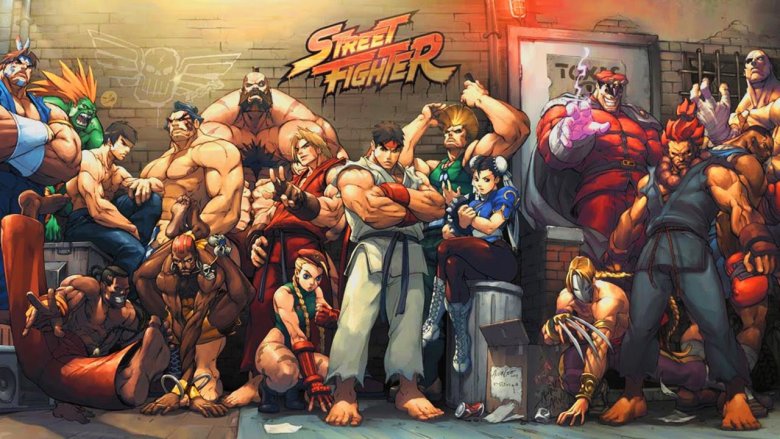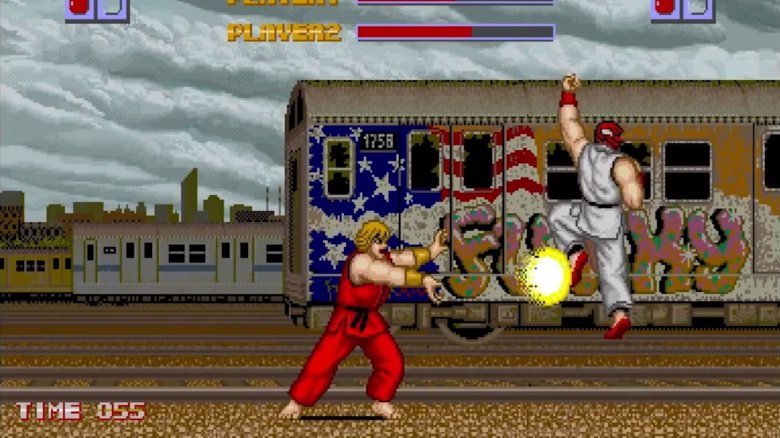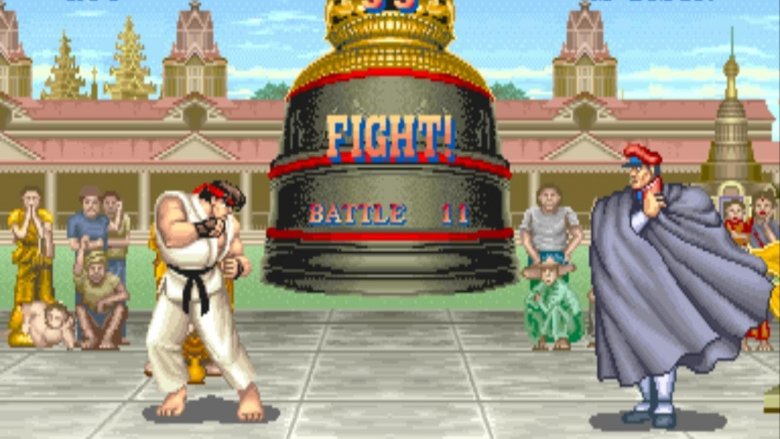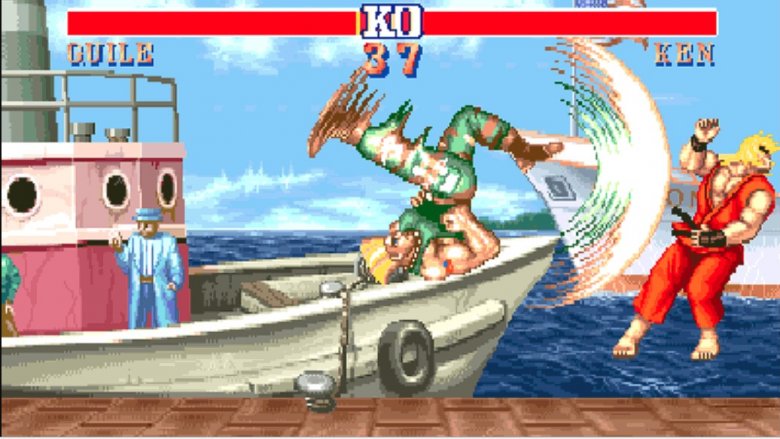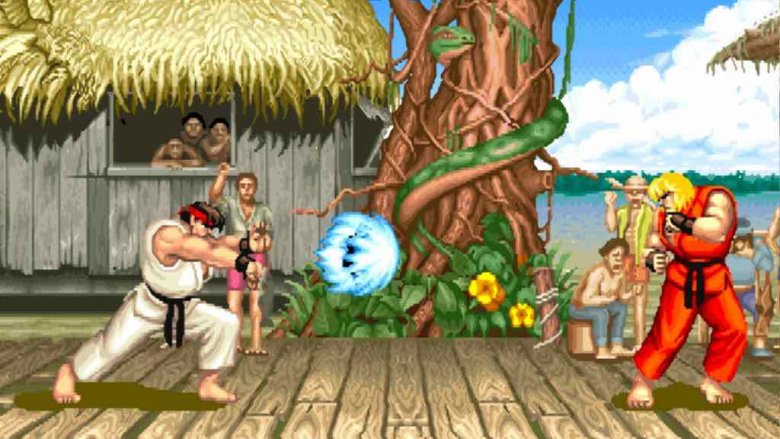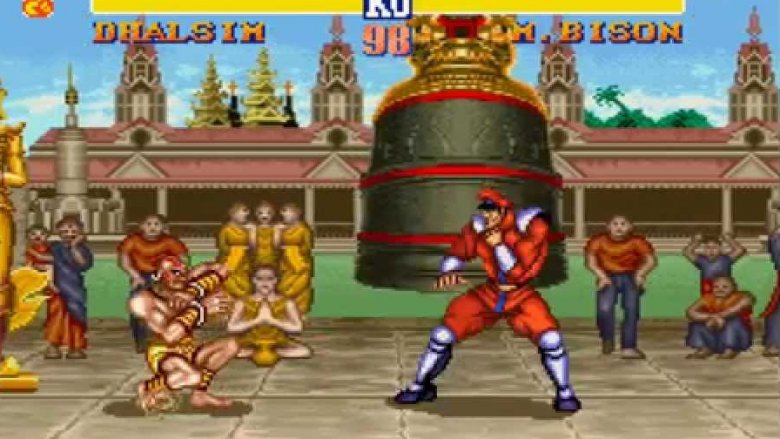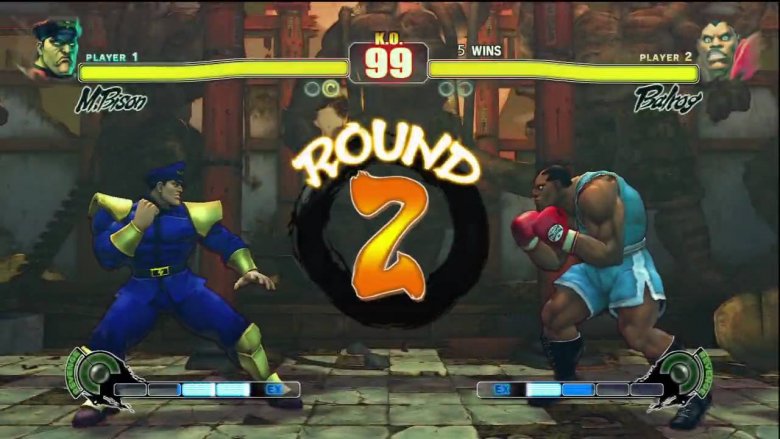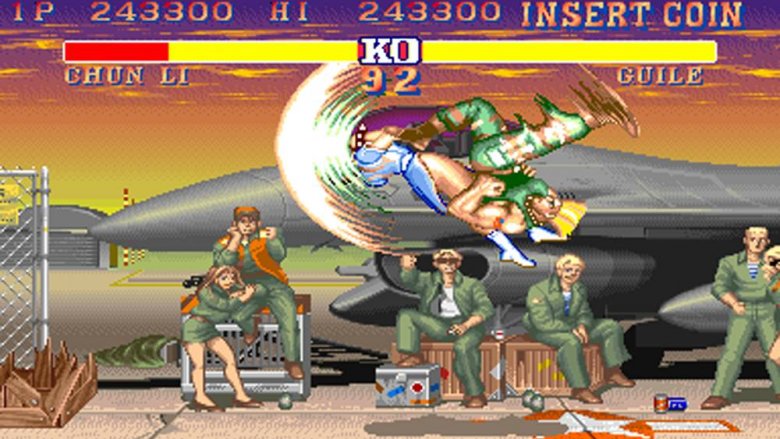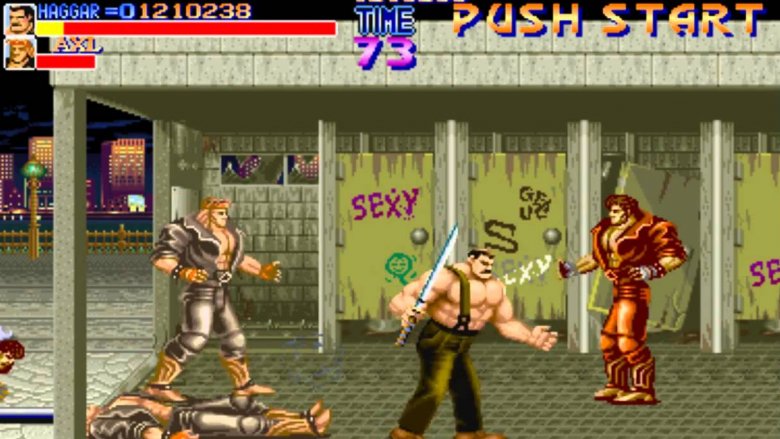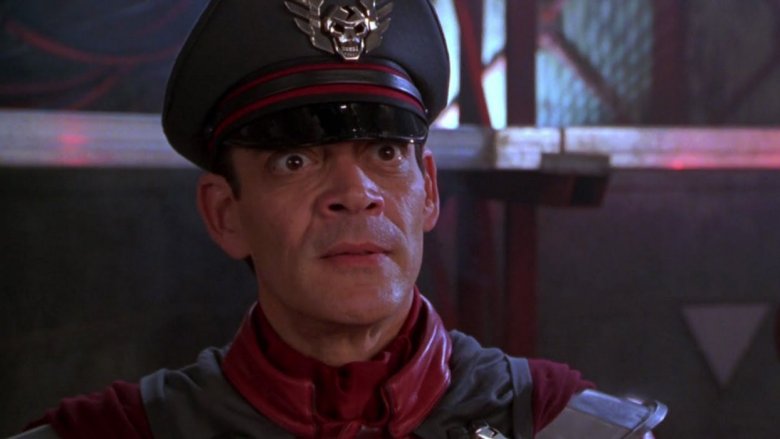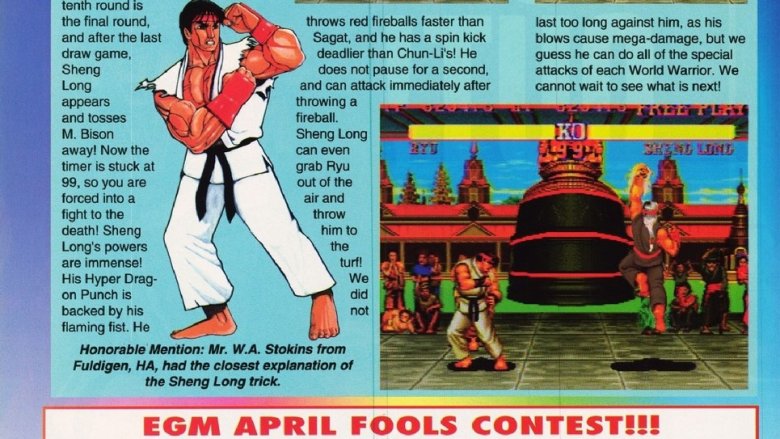The Untold Truth Of Street Fighter
If you've spent any amount of time in an arcade, chances are you've played one of the many, many installments of the Street Fighter franchise. A mainstay of arcade fighting games and likely the reason for a lot of childhood friendships getting destroyed, the Street Fighter franchise has defined the style of fighting games for decades with a strong visual identity, a massive roster of playable characters, and a ridiculously high skill ceiling for talented players.
Ironically, even though the franchise is so distinctly recognizable, the actual origin of the series stems from a hodgepodge of inspirations, outright thefts, and April Fool's Day pranks becoming canon. Whether you're talking about the original Street Fighter game or Street Fighter II: The World Warrior Turbo, there's a lot of core qualities that are inspired from some unlikely sources. From Mike Tyson's namesake getting loaned to the series' main villain to Raul Julia's immortal line readings in the Street Fighter movie, here is the untold truth of Street Fighter.
Punch Pads
While Street Fighter II set the standard that gamers would come to know and love, the original Street Fighter game pioneered some of the more iconic traits of the series. The complexity of the fighting style, the multiple fight locations, and even some character designs would go on to become core tenets of the franchise going forward. Still, while main character Ryu and his best buddy Ken would survive to the sequel, there was one design element for the original game that ended up getting nixed in future installments.
While most gamers are familiar with Street Fighter's six-button layout (light punch, medium punch, strong punch, with the same for kicks), an alternate version of the original game had two pads that players could strike; the pads would translate the force of the hit into the "light, medium, and heavy" categories. As with anything that involves players actually hitting something, there was a not-insignificant chance of injury, leading developer Capcom to stick with the tried and true "button and joystick" style.
The World Warrior
Chances are that if you're a fan of the franchise, you're actually a fan of Street Fighter II. While the original game utilized the complicated fighting system, it was the sequel that turned the game into a worldwide smash. Street Fighter II gave players the ability to play as any one of a packed roster of new, unique characters each with their own special attacks and timing. The addition of new characters wasn't the only improvement, either; the new game came with a complete overhaul in graphics and animation style that made the game look more fluid and engaging than most other games on the market.
Add in newly destructible environments, individual plotlines, and improved responsiveness in the controls and it's no wonder that the game became such a huge worldwide success. Still, for as much as Street Fighter II inarguably improved on the original, one of its most defining features came about completely by accident and would change the face of fighting games forever.
Accidental combo
The accidental innovation that made Street Fighter II a must-have, instead of just a vastly improved sequel, was the ability to string together attacks into combos. A glitch in the programming gave savvy players the ability to cancel a move action by pressing certain different attacks, allowing for attacks be strung together. The glitch was a result of the game programmers worrying that the original super attacks had been too difficult to string together in the original Street Fighter. To make it more forgiving for players to unleash a well-timed Hadouken, the response time to attacks was delayed just long enough to fix wayward presses.
Supposedly, the design team was unaware that combos were even possible, but with the incredibly popular game introducing millions of players to the possibility of combo attacks in fighting games, a defining trait in the genre was born. Nowadays, it's basically unheard of for any fighting game to lack combo capability.
Ryu centers the series
While the Street Fighter franchise is known for its massive roster of characters, the martial artist Ryu has always been at the center of the game series. His straightforward character and basic moveset gave the series room to expand into increasingly outlandish character designs and fighting styles. To put it another way, you can't have Wolverine without having the straight and narrow Cyclops. But for as much as Ryu is emblematic of Street Fighter as a whole, he's not entirely original.
His visual look is strongly influenced by Yoshiji Soeno, a character from the classic Japanese comic series Karate Baka Ichidai, a famous manga that was running at the time that Street Fighter was in development. Beyond just the visual appeal, his commitment to outlandish training trips and desire to test his strength is clearly inspired by the famed Masutatsu Oyama, arguably one of the most famous martial artists in history. In a nice moment of circuitous inspiration, Oyama was the inspiration for Karate Baka Ichidai, which in turn inspired Ryu.
Ryu's not the only Street Fighter character that's inspired by real-life figures and other creative works, though.
Dhalsim and M. Bison were remakes -- or rip-offs
Sometimes those inspirations border on near-outright theft. Dhalsim is one of Street Fighter's most iconic character designs: a yoga master who can extend his limbs to knock out an inattentive player. The character's trademark limb-stretching and Indian heritage is almost a direct match to the Indian yogi featured in Master of the Flying Guillotine. The movie's a classic of the martial arts movie genre, and its story of a fighting tournament filled with outlandish characters was a clear inspiration for Street Fighter as a whole. That said, Yoga Tro La Seng is so close to Dhalsim that it borders on litigious.
Dhalsim's not the only one; the main villain of the franchise, Vega (M. Bison in America) is clearly based on the villain from Tokyo: The Last Megalopolis. While the overall design of Dhalsim was slightly adjusted, Vega's costume is a direct match for the villain in the dystopian thriller.
Name confusion
In Japan, the main villain of Street Fighter II is Vega, the claw-wielding character is called Balrog, and the boxing dynamo is M. Bison. M. Bison's name and look is pretty clearly based on famed heavyweight champion, Mike Tyson (M. Tyson, M. Bison: get it?). When the game was translated overseas, the developers worried that the obvious name use would leave them open to lawsuits, so they came up with an inventive, if confusing, plan. The name M. Bison would be moved to the villain; in response, Vega would become the claw-wielding character, and Balrog would become the moniker of the boxing character.
The name change stuck, and M. Bison is firmly established in American audiences' minds as the main villain instead of an obvious play on Mike Tyson's name. This does pose a problem for international Street Fighter competitions though, so there's a compromise to keep the characters straight. The boxing character is called "Boxer," the Spanish Knight character is called "Claw," and the villain is called "Dictator." A pretty elegant solution to the name change, if you ask us.
Fan improvement
Street Fighter II was a huge success, as mentioned above, but it was as success in more ways than one. While the game proved incredibly popular with fans and the average gamer, it also proved very popular with fans looking to modify the game set to suit more fast-paced competitive needs. A slew of fan-modded games were passed back and forth featuring improved move-sets, faster combat, and even entirely new special attacks.
Some of these fan-edited games included the ability to change character mid-fight, utilize special moves in the air, and basically destroy an opponent while playing as Zangief. These fan-modded games became so popular that Capcom ended up unofficially borrowing some of the better ideas in the fan-edits. Of course, there was never any official confirmation, but later updated releases of Street Fighter II would include similar attack patterns and the faster-paced combat systems originated in fan-edits like Street Fighter: Rainbow Edition.
The other Street Fighter II: Final Fight
Plenty of fans would say that Street Fighter II is their favorite installment in the franchise, but there was almost an entirely different sequel to the original Street Fighter: Street Fighter '89. The problem? Street Fighter '89 was basically an entirely different game, one much closer to Double Dragon's style of arcade beat-em-ups than Street Fighter's complex fighting mechanics.
Street Fighter '89 would be renamed Final Fight and would start an entirely different franchise, albeit one slightly less beloved than Street Fighter. Those involved have different recollections about why exactly that happened; developer Yoshiki Okamoto claims that they changed the name because the Street Fighter brand was so disliked following the original game. By contrast, lead artist Akira Yasuda says that the game's name was changed because the completed game was so completely different from the original Street Fighter game. Either way, some of the characters from later Final Fight games would end up in the ever-expanding roster of playable characters in Street Fighter, finally bringing the two franchises back together.
Street Fighter: The Movie was just plain insane
While video game movies have never been well-received, Street Fighter: The Movie is famous for being a bit of a mess. Even with the casting of Jean Claude Van Damme, the story is still a bizarre combination of characters from Street Fighter II and various plot threads from 90s Van Damme movies. Still, the movie's undeniably fantastic, if only for Raul Julia's scene-stealing performance as M. Bison. As Bison, Julia commands the viewer's attention like the fictional dictator that he plays. Incredibly, Julia's performance was delivered while the beloved actor was dying of terminal cancer.
Apparently, Julia took the role in the film in order to show his kids a movie they would enjoy, since they were such big fans of the game franchise. Beyond Julia's iconic role, the movie is also notable for inspiring Street Fighter: The Movie: The Game. Beyond sounding like a rejected headline from The Onion, the game was an attempt to capture the audience of the more realistic Mortal Kombat series, although it was reviewed even worse than the movie it was based on.
Joke turned into reality
While we've talked about the various influences that inspired the characters and customization of the Street Fighter franchise, it's an April Fools' joke that is arguably one of Street Fighter's greatest legacies. In the video game magazine EGM Monthly, an April Fool's joke article explained to readers that there was a secret video game boss only accessible by gamers willing to complete a veritable gauntlet of ridiculous demands. The myth originated from a famous mistranslation of game text that implied that "Sheng Long," the name of Ryu's dragon punch, was actually a secret boss character.
Gullible gamers spent hours trying to unlock the secret Sheng Long character, ranking the video game myth up there with "Aeris doesn't have to die in FFVII" as constant playground gossip. The punchline to this mass illusion was that Street Fighter II: Turbo would actually add a secret boss to the end of the game only for gamers who could perform nearly perfectly; Akuma, the demonic escalation of M. Bison's more human villainy. Sheng Long himself would later be added to the series as Ryu and Ken's mentor.

